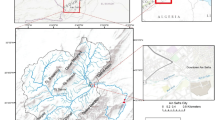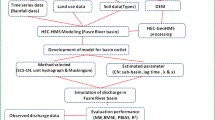Abstract
Ideal watersheds of simple geometries, characterized by dominant processes involved in rainfall–runoff transformation, can provide model users/developers with detailed insights into hydrological components. In the present paper, some models were evaluated against available laboratory data on impervious rectangular and V-shaped (open-book) watersheds. The HEC-HMS as a numerical hydrologic model was adopted along with analytical solution of the kinematic wave approximation. The numerical methods used in HEC-HMS model involve finite difference method. Simulations were performed for various cases formed through variation of watershed slope and rainfall intensity. The outputs of the models involved runoff hydrographs, time to peak discharge and maximum discharge. For the rectangular watershed, numerical solution of KW within HEC-HMS was applied while for the V-shaped case, the numerical solution of KW in HEC-HMS and DWSM models and nonlinear reservoir scheme in SWMM model were compared. According to the results, in the rectangular watershed case, numerical model of KW within HEC-HMS showed good performance with relative accuracy of 69.2% and 96.0% in estimation of time to peak discharge and maximum discharge, respectively. In the case of V-shaped watershed, all rainfall–runoff models provided satisfactory results so that the nonlinear reservoir scheme in SWMM model outperformed the KW model. Moreover, regarding the kinematic wave solution schemes, finite difference (KW in HEC-HMS) and shock fitting (KW in DWSM) were shown to be similar in efficiency with the Nash–Sutcliffe efficiency index of 0.94.







Similar content being viewed by others
Abbreviations
- A :
-
Cross-sectional area (L2)
- A x :
-
Rectangular area of cross section (L2)
- d :
-
Depth of excess ponds atop the sub-watershed surface (L)
- d s :
-
Depth of ponded water above the depression stage
- e :
-
Surface evaporation rate (L/T)
- f :
-
Infiltration rate (L/T)
- h :
-
Height of flow (L)
- h L :
-
Height of flow at a specific distance (L)
- i R :
-
Rainfall intensity (L/T)
- \({i}_{r+s}\) :
-
Sum of intensity of rainfall and snowmelt (L/T)
- j :
-
Integer for time increment (T)
- L ov :
-
Length of overland plane (L)
- n :
-
Manning’s roughness coefficient
- E :
-
Nash–Sutcliffe efficiency
- q :
-
Flow per unit width of watershed (L3/T/L)
- q L :
-
Lateral inflow per unit width of watershed (L3/T/L)
- q j :
-
Discrete q along the x-axis (L3/T/L)
- Q :
-
Outlet discharge (L3/T)
- Q e :
-
Equilibrium discharge (L3/T)
- Q o :
-
Average observed runoff over the entire experiment at a fixed time step Δt (L3/T))
- Q oi :
-
Observed runoff at time ti (L3/T)
- Q si :
-
Simulated runoff at time ti (L3/T)
- R x :
-
Hydraulic radius associated with watershed area and (L)
- S :
-
Average slope of the sub-watershed(L/L)
- s ov :
-
Bed slope (L/L)
- t :
-
Time (T)
- t b :
-
Hydrograph base time (T)
- t eo :
-
Equilibrium time (T)
- t p :
-
Maximum of observed discharges time (T)
- W :
-
Channel width (L)
- x :
-
Distance along the flow point (L)
- α :
-
Kinewater wave parameter
- β :
-
Kinewater wave parameter
- \(\frac{\partial A}{{\partial t}}\) :
-
Difference in area in successive times
- \(\frac{\partial A}{{\partial x}}\) :
-
Difference in area at adjacent locations
- Δt :
-
Time step (T)
- Δx:
-
Space step (L)
References
Barszcz M (2015) The application of the SWMM model to forecast probable flows in urban catchment. Sci Rev Eng Environ Sci 24(3):209–223
Borah DK, Prasad SN, Alonso CV (1980) Kinematic wave routing incorporating shok fitting. Water Resour Res 16(3):529–541
Borah DK, Xia R, Bera M (2002) DWSM—A dynamic watershed simulation model. In: Singh VP, Frevert DK (eds) Mathematical models of small watershed hydrology and applications. Water Resources Publications, Highlands Ranch, Colorado, pp 113–166
Chakravarti A, Jain MK (2014) Experimental invesitigation and modeling of rainfall runoff process. Indian J Sci Technol 7(12):2096–2106
Chaudhry HC (1993) Open-channel hydraulics. Prentice Hall, NJ
Chow VT (1959) Open channel flow. McGraw-Hill, New York, NY
Chow VT, Maidment DR, Mays LW (1988) Applied hydrology. McGraw Hill, New York, NY
Ding Y, Jia Y, Wang SSY (2004) Identification of Manning’s roughness coefficients in shallow water flows. J Hydraul Eng 130(6):501–510. https://doi.org/10.1061/(ASCE)0733-9429(2004)130:6(501)
Ekwueme BN, Agunwamba JC (2020) Modeling the Influence of Meteorological variables on runoff in a tropical watershed. Civ Eng J 6(12):2344–2351. https://doi.org/10.28991/cej-2020-03091621
Gao P, Borah DK, Josefson M (2013) Evaluation of the storm event model DWSM on a medium-sized watershed in central New York, USA. J Urban Environ Eng 7(1):1–7
Halwatura D, Najim MMM (2013) Application of the HEC-HMS model for runoff simulation in a tropical catchment. Environ Model Softw 46:155–162
Her Y, Heatwole C (2016) Two-dimensional continuous simulation of spatiotemporally varied hydrological processes using the time-area method. Hydrol Process 30(5):751–770. https://doi.org/10.1002/hyp.10644
Huber WC, Dickinson RE (1988) Stormwater Management Model, version 4 Part A: user’s manual. Environmental Protection Agency, U.S
Jaber FH, Mohtar RH (2003) Stability and accuracy of two-dimensional kinematic wave overland flow modeling. Adv Water Resour 26(11):1189–1198. https://doi.org/10.1016/S0309-1708(03)00102-7
Kavianpour M et al (2020) Copula based spatial analysis of drought return period in southwest of Iran. Period Polytech Civil Eng 64(4):1051–1063
Kirstetter G, Hu J, Delestre O, Darboux F, Lagree P-Y, Popinet S, Fullana JM, Josserand C (2016) Modeling rain-driven overland flow: Empirical versus analytical friction terms in the shallow water approximation. J Hydrol 536:1–9. https://doi.org/10.1016/j.jhydrol.2016.02.022
Lacasta A, Morales-Hernández M, Brufau P, García-Navarro P (2017) Calibration of the 1D shallow water equations: a comparison of Monte Carlo and gradient-based optimization methods. J Hydroinform 19(2):282–298. https://doi.org/10.2166/hydro.2017.021
Leclerc G, Schaake JC (1973) Methodology for assessing the potential impact of urban development on urban runoff and the relative efficiency of runoff control alternatives. Massachusetts Institute of Technology, Cambridge, Massachusetts
Liang J, Melching CS (2012) Comparison of computed and experimentally assessed times of concentration for a v-shaped laboratory watershed. J Hydrol Eng 17(12):1389–1396. https://doi.org/10.1061/(ASCE)HE.1943-5584.0000609
Lighthil MJ and Whitham GB (1955) On kinematic waves. I. Flood movement in long rivers. Proc Royal Soc Lond.
Nash JE, Sutcliffe JV (1970) River flow forecasting through conceptual models part I—a discussion of principles. J Hydrol 10(3):282–290. https://doi.org/10.1016/0022-1694(70)90255-6
Oo HT, Zin WW, Kyi CCT (2020) Analysis of streamflow response to changing climate conditions using SWAT model. Civ Eng J 6(2):194–209
Rai PK, Chahar BR, Dhanya CT (2016) GIS-based SWMM model for simulating the catchment response to flood events. Hydrol Res 48(2):384–394
Saghafian B (2006) Nonlinear transformation of unit hydrograph. J Hydrol 330(3–4):596–603. https://doi.org/10.1016/j.jhydrol.2006.04.026
Saghafian B, Julien PY (1995) Time to equilibrium for spatially variable watersheds. J Hydrol 172(1–4):231–245. https://doi.org/10.1016/0022-1694(95)02692-I
Saghafian B, van Lieshout AM, Rajaei HM (2000) Distributed catchment simulation using a raster GIS. Int J Appl Earth Obs Geoinf 2(3–4):199–203. https://doi.org/10.1016/S0303-2434(00)85014-X
Saghafian B, Shokoohi A (2006) A corrected time-area technique for one-dimensional flow. Int J Civil Eng 4(1):34–41
Shen YY(1974) Experimental investigation of watershed surface runoff. Hydraulic engineering series no 29, University of Illinois
Singh VP (1996) Kinematic wave modeling in water resources: surface water hydrology. John Wiley and Sons, New York
Singh VP, Woolhiser DA (2002) Mathematical modeling of watershed hydrology. J Hydrol Eng 7(4):270–292. https://doi.org/10.1061/(ASCE)1084-0699(2002)7:4(270)
Troch P, van Loon E, Hilberts A (2002) Analytical solutions to a hillslope-storage kinematic wave equation for subsurface flow. Adv Water Resour 25(6):637–649. https://doi.org/10.1016/S0309-1708(02)00017-9
US Army Corps of Engineers (USACE) (2000) Hydrologic modeling system HEC-HMS technical reference manual. Hydrologic Engineering Center, Davis
Xiong Y, Melching CS (2005) Comparison of kinematic-wave and nonlinear reservoir routing of urban watershed runoff. J Hydrol Eng 10(1):39–49. https://doi.org/10.1061/(ASCE)1084-0699(2005)10:1(39)
Zema DA et al (2016) ‘Comparing different infiltration methods of the HEC-HMS model: the case study of the mésima torrent (Southern Italy): infiltration methods of the HEC-HMS model in torrents of South Italy. Land Degrad Dev 28(1):294–308
Zuazo V, Gironás J, Niemann JD (2014) Assessing the impact of travel time formulations on the performance of spatially distributed travel time methods applied to hillslopes. J Hydrol 519:1315–1327. https://doi.org/10.1016/j.jhydrol.2014.09.035
Acknowledgements
Thanks are due to Dr. Charles Melching for providing Illinois laboratory watersheds data, and to anonymous reviewers for their helpful comments.
Author information
Authors and Affiliations
Corresponding author
Rights and permissions
About this article
Cite this article
Mohammadi Hashemi, M., Saghafian, B., Zakeri Niri, M. et al. Applicability of Rainfall–Runoff Models in Two Simplified Watersheds. Iran J Sci Technol Trans Civ Eng 46, 3295–3306 (2022). https://doi.org/10.1007/s40996-021-00733-5
Received:
Accepted:
Published:
Issue Date:
DOI: https://doi.org/10.1007/s40996-021-00733-5




